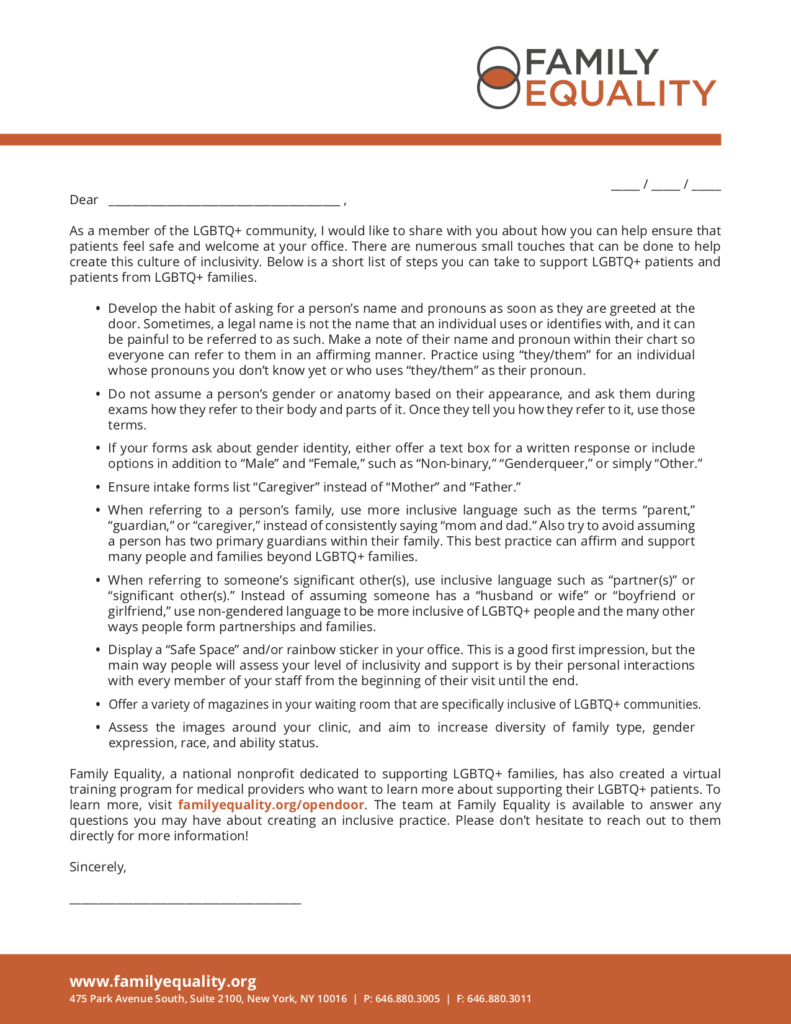We’re excited to share two new resources for our families, our Safe Schools and Medical Provider template letters. These forms have been designed to be downloaded, filled in, and printed out to help make your community more sensitive to the needs of LGBTQ+ Families.
The Medical Provider form can be shared with any provider you work within the community, from physicians and dentists to therapists and chiropractors, to assist them in making changes to their practice and office space that foster a culture of inclusivity.
Plain text template:
_____ / _____ / _____
Dear ________________________________________ ,
As a member of the LGBTQ+ community, I would like to share with you about how you can help ensure that patients feel safe and welcome at your office. There are numerous small touches that can be done to help create this culture of inclusivity. Below is a short list of steps you can take to support LGBTQ+ patients and patients from LGBTQ+ families.
- Develop the habit of asking for a person’s name and pronouns as soon as they are greeted at the door. Sometimes, a legal name is not the name that an individual uses or identifies with, and it can be painful to be referred to as such. Make a note of their name and pronoun within their chart so everyone can refer to them in an affirming manner. Practice using “they/them” for an individual whose pronouns you don’t know yet or who uses “they/them” as their pronoun.
- Do not assume a person’s gender or anatomy based on their appearance, and ask them during exams how they refer to their body and parts of it. Once they tell you how they refer to it, use those terms.
- If your forms ask about gender identity, either offer a text box for a written response or include options in addition to “Male” and “Female,” such as “Non-binary,” “Genderqueer,” or simply “Other.”
- Ensure intake forms list “Caregiver” instead of “Mother” and “Father.”
- When referring to a person’s family, use more inclusive language such as the terms “parent,” “guardian,” or “caregiver,” instead of consistently saying “mom and dad.” Also try to avoid assuming a person has two primary guardians within their family. This best practice can affirm and support many people and families beyond LGBTQ+ families.
- When referring to someone’s significant other(s), use inclusive language such as “partner(s)” or “significant other(s).” Instead of assuming someone has a “husband or wife” or “boyfriend or girlfriend,” use non-gendered language to be more inclusive of LGBTQ+ people and the many other ways people form partnerships and families.
- Display a “Safe Space” and/or rainbow sticker in your office. This is a good first impression, but the main way people will assess your level of inclusivity and support is by their personal interactions with every member of your staff from the beginning of their visit until the end.
- Offer a variety of magazines in your waiting room that are specifically inclusive of LGBTQ+ communities.
- Assess the images around your clinic, and aim to increase diversity of family type, gender expression, race, and ability status.
Family Equality, a national nonprofit dedicated to supporting LGBTQ+ families, has also created a virtual training program for medical providers who want to learn more about supporting their LGBTQ+ patients. To learn more, visit familyequality.org/opendoor. The team at Family Equality is available to answer any questions you may have about creating an inclusive practice. Please don’t hesitate to reach out to them directly for more information!
Sincerely,

